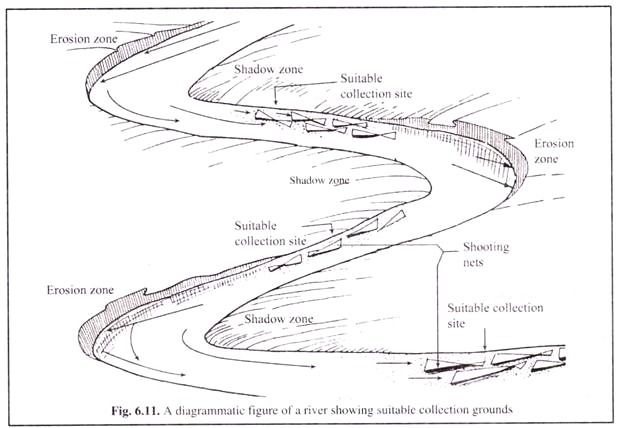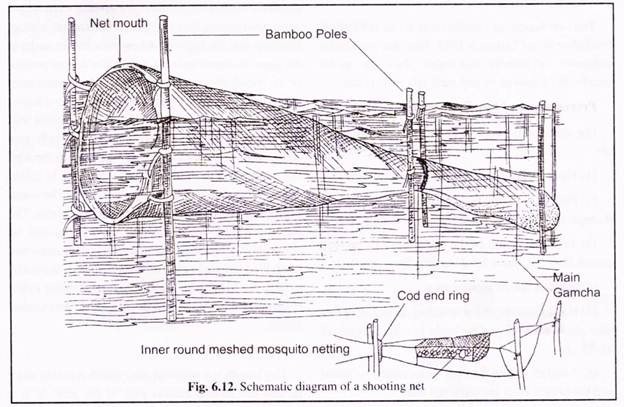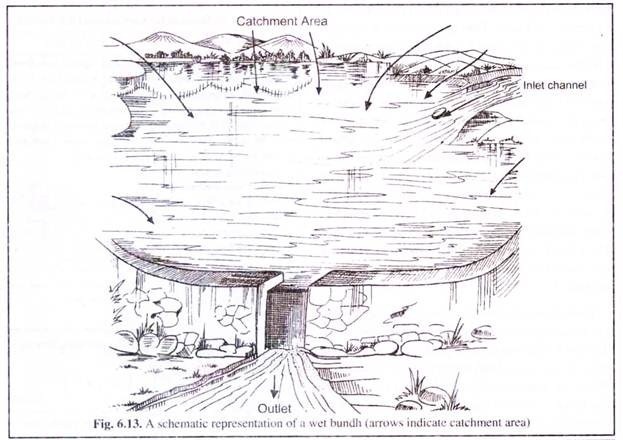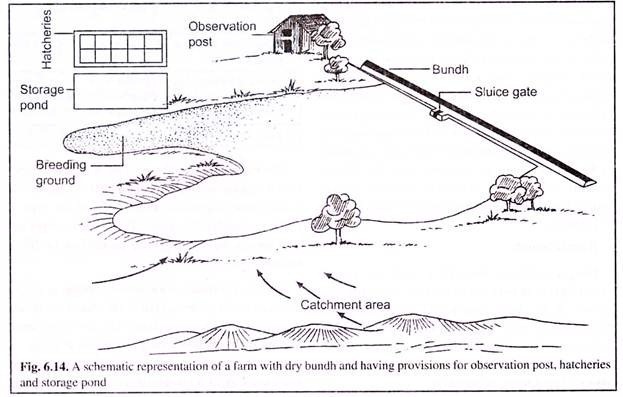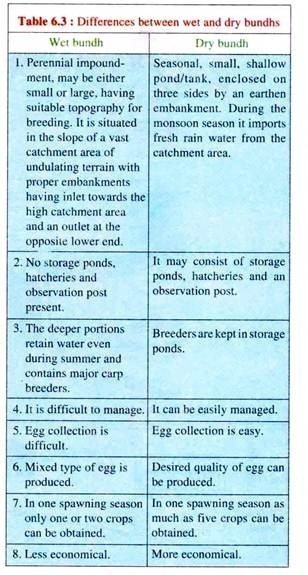The following points highlight the three main ways of procurement of fish seed. The ways are: 1. Procurement of Seeds from Riverine Source 2. Bundh Breeding 3. Induced Breeding.
Way # 1. Procurement of Seeds from Riverine Source:
Rivers in India form a major source of collection of fish seeds during the monsoon. At one time (1964-65) the riverine seed collection contributed about 91.67% of India’s total fish seed production. At present with the advent of aquaculture techniques and the rise of pollution in the rivers, the fish seed farms has taken the leading role in fish seed production.
The rivers acquiring a serpentine course, show bends and curves at various places (Fig. 6.11). The flowing water current of the river particularly during the monsoon, results in the erosin of the bank on one side, called the Erosion zone. Just opposite to it is the flat, gentle sloping bank, called the Shadow zone. Both these sites are unsuitable for fish seed collection.
Good collection areas are located on the side of the sloping bank, at a place where the water current just diverges, casting fish seed to the sides. From such areas a large number of fish seeds are collected with the help of a shooting net (Fig. 6.12) which is a funnel-shaped net of finely woven netting. It is operated in shallow margins of the flooded river with its mouth facing the water current.
At the cod end a ring of split bamboo or cane is stitched. To this a receptacle is attached (called gamcha) during the time of operation. The gamcha is generally shaped like a monk’s hood. The spawns, carried by the current move into the shooting net, are collected in the gamcha.
From here they are periodically scooped, seived through a strainer to remove larger organisms and debris. Before the spawns are transported to nurseries, they are kept in earthern pots, earthernware containers (‘hundies’) or in hapas.
Before collection procedures are undertaken, spawn prospecting investigations are carried out to identify potential centres for egg, spawn, fry or finger- ling. The available statistical analysis indicates that, as compared to egg/spawn collection centres, the established fry/fingering collection centres are few.
Way # 2. Bundh Breeding:
Bundh is a type of perennial and seasonal tank or impoundment where riverine conditions are simulated and where major carps are known to breed. After a heavy shower, the bundhs receive large quantity of rain water with washings from their catchment areas and provide large shallow areas that serve as spawning grounds for the fishes.
ADVERTISEMENTS:
The first bundh (dry bundh) was set up in Madhya Pradesh at Sonar Talliya in 1958. After this, persistent expansion of bundhs had taken place due to its simplicity of operation and high rate of success.
Types of Bundh:
Bundhs are generally of three types:
(A) Wet Bundhs and
ADVERTISEMENTS:
(B) Dry Bundhs.
(C) Bangla Bundh
A. Wet Bundhs:
Wet bundhs are perennial ponds situated in the slope of an undulating terrain. It provides a vast catchment area and facilitates quick filling even with a short spell of rain. It has proper embankments with an inlet towards the high catchment area and an outlet at the opposite lower end (Fig. 6.13).
The deeper portion of the bundh during summer, retain water containing major carp breeders. During monsoon, after a heavy shower, water from the catchment area rushes into the bundh. The major portion of the bundh gets submerged and the excess water passes out through the outlet. The shallow areas of the bundh is called moans where the breeders actually spawn.
The outlet is protected by a bamboo fencing called chheva. The outflow of the water through the chheva can be controlled by blocking the spaces in it with straw and mud. Fine meshed nylon cloth is placed in the outlet to stop the hatchlings from escaping. Similar nylon cloth is placed i n the inlet to stop the entry of unwanted fishes.
B. Dry Bundhs:
Dry bundh is a seasonal one, which remains more or less dry during greater part of the year. It is a shallow depression enclosed on three sides by an earthen embankment. During the monsoon season it imports fresh rain-water from the catchment area.
ADVERTISEMENTS:
In modern constructions, the embankment is a pucca stone masonry with a small sluice gate in the deepest portion of the bundh for complete drainage and one or two waste weirs for overflow of excess water.
A dry bundh unit (apart from the bundh) also consists of storage ponds for stocking breeders, an observation post with arrangement for storing necessary equipment and a set of cemented hatcheries (2.4 m x 1.2 m x 0.3 m) along with overhead tank and regular supply of water for handling large number of eggs at a time (Fig. 6.14).
In dry bundhs, selected numbers of female and male (in the ratio 1:2) breeders of major carps are introduced.
Though major carps breed at any spot in the bundh, it is advantageous to prepare ‘spawning grounds’ at different levels which could get flooded at different water levels. It has been stated that the water depth where sex play/courtship behaviour and spawning take place, varies between 8 cm and 1.2 m.
In both wet and dry bundhs, spawning usually occurs after a large quantity of rain water fills up the bundh during continuous heavy showers of the monsoon period. It has been seen that at first smaller sized mature fishes (rohu, mrigal) get stimulated to breed and in order to spawn, migrate either to the shallow areas of the bundh or to those adjoining it.
Bigger fishes, like catla, spawn next in the same area. Spawning occurs on hard or sandy soil and on rocky embankment. In one year (spawning season of 30-40 days) as much as five crops could be obtained in a dry bundh, whereas only one or two crops possible in wet bundh. The difference between wet and dry bundh is listed in Table 6.3
Prerequisites of Bundh Breeding:
For successful bundh breeding the prerequisites are:
(1) Heavy showers during the monsoon season.
(2) Flow of water from up-land to bundhs and then through outlet, makes some sort of water current.
(3) Inlet and outlet of the bundhs are to be kept closed after the water level reaches brim point.
(4) Sudden fall of temperature.
(5) No definite depth for breeding, as breeding can take place even in paddy fields having a depth of 31-35 cm.
(6) Smaller fishes first get inducement to breed and the bigger ones are attracted later.
Drawbacks of Bundh Breeding:
(1) Indiscriminate killing of brood fishes particularly milters during dry months, result in improper sex ratio.
(2) It is not possible to hygienically maintain mud hatching pits.
(3) Large scale mortality of spawn takes place as they are not transported before the 3rd day.
(4) Other limiting factors for successful spawning are:
(a) Presence of excessive numbers of copepods (Cyclops, Diaptomus, etc.) that accumulate in the water of the bundh.
(b) Large scale deposition of alluvium in the breeding grounds.
Way # 3. Induced Breeding:
Many cultural species of fin fishes (particularly the major corps) under farm culture conditions, do not get the required environmental impetus for spontaneous maturation. This has led to the development and standardisation of a technique, called induced breeding or hypophysation.
Here, through the injection of pituitary homogenates or extracts, the natural gonadotropin surge is stimulated, disregarding the environmental impetus. Thus, it has not only made the major carps and other fin fishes to breed in confined water under farm conditions but it also has the added advantage of regulating the time of spawning.
Induced spawnings first trial was carried out in the 1930’s in South America (Brazil), where pituitary hormones obtained from cattle and sheep were used to induce spawn mrigal. In India, the first experiment in induced breeding was made by Hamid Khan (1937) who tried in vain to induce breed mrigal by the injection of mammalian pituitary gland.
The first successful attempt was made by Hiralal Chaudhuri in 1955, who succeeded to induce spawning Esomus dauricus (minor carp) by injecting pituitary gland of catla. Later in 1957, H. Chaudhuri and K.H. Alikunhi succeeded to induce breeding of Indian major carps at the Central Inland Fisheries Research Sub-station, Cuttack.
Advantages of Induced Breeding:
Induced breeding has manifold advantages as under:
(1) Pure and disease-free spawn of a desired variety of fish under cultivation can be obtained through induced breeding.
(2) Induced breeding ensures availability of seeds for fish culture at any time (except during the winter months) and do not have to depend upon the monsoon season only for its collection, like that of natural sources.
(3) The demand for any specified quality of pure fish seed of a particular species can be met through induced breeding.
(4) The same fish can be made to breed twice in one year.
(5) The technique of induced breeding is very simple and can be easily handled by a layman without much training.
(6) The cost incurred for production of a spawn from induced breeding is comparatively lower than that of obtaining from natural sources.
